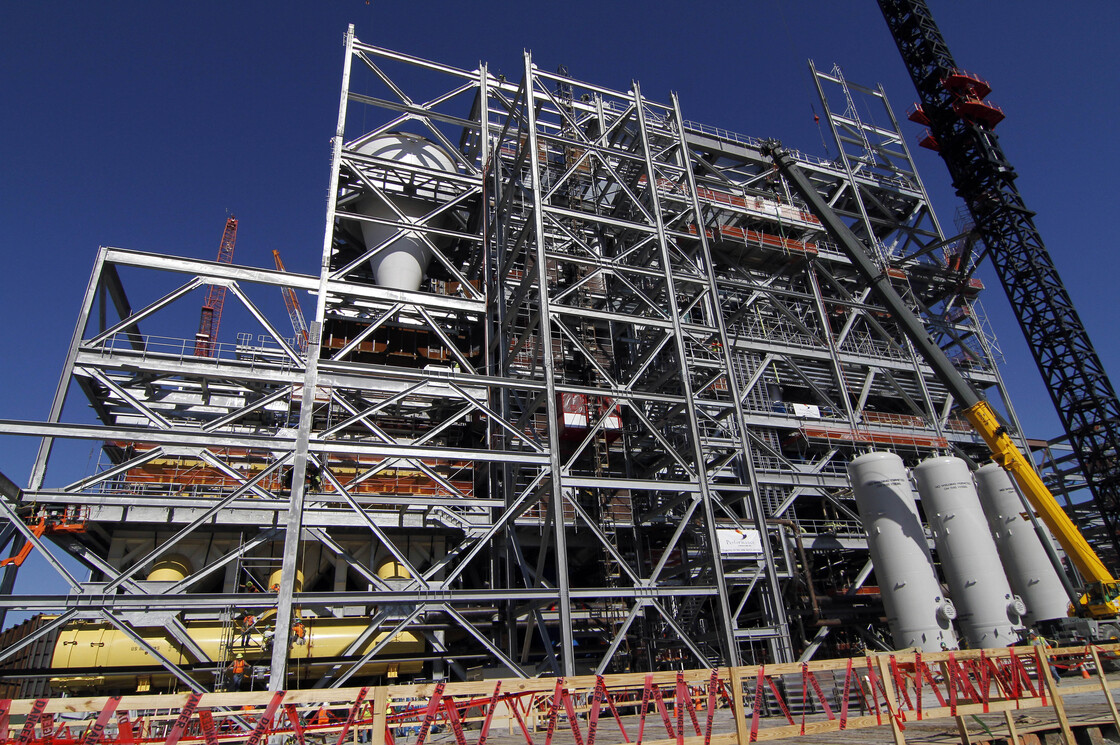
Mississippi Power's Kemper County energy facility near DeKalb, Miss., seen under construction last year. Carbon dioxide will be captured from this plant and used to stimulate production of oil from existing wells.
Rogelio V. Solis/APThe Environmental Protection Agency's second stab at a proposal to set the first-ever limits on greenhouse gas emissions from new power plants would make it impossible for companies to build the kind of coal-fired plants that have been the country's biggest source of electricity for decades.
Under the proposal, released Friday, any new plant that runs on coal would be permitted to emit only about half as much carbon dioxide as an average coal plant puts into the air today.
EPA administrator Gina McCarthy tells NPR the steps the EPA is proposing in the rule to address climate change "can actually form the basis for a sound economy, while at the same time we can begin to tackle what is essentially the most significant public health challenge of our time."
The gasifier facility, still under construction last year at the energy plant. Under the EPA's proposed rules, new plants that run on coal would have to find ways to emit less than half the carbon dioxide current coal plants emit.
Rogelio V. Solis/AP The gasifier facility, still under construction last year at the energy plant. Under the EPA's proposed rules, new plants that run on coal would have to find ways to emit less than half the carbon dioxide current coal plants emit.Rogelio V. Solis/AP
The gasifier facility, still under construction last year at the energy plant. Under the EPA's proposed rules, new plants that run on coal would have to find ways to emit less than half the carbon dioxide current coal plants emit.Rogelio V. Solis/AP The EPA proposal aims to help the White House meet its plan to cut greenhouse gas emissions by attacking the largest single source in the United States: Power plants pump out 40 percent of the nation's greenhouse gases.
The EPA's new proposal sets a limit for future power plants of 1,000 pounds of carbon dioxide per megawatt hour for large electricity generators that are powered by natural gas. And it sets a slightly higher limit of 1,100 pounds of CO2 per megawatt hour for small natural-gas generators and for coal-fired generators.
Although the EPA says its rule is legally sound, electric utility companies are already arguing that it goes further than the law allows.
The only technologies that exist to make coal plants clean enough to meet this proposed standard, industry executives say, are far too expensive and haven't been proved at a commercial scale. Making coal plants clean enough, they say, would add hundreds of millions of dollars to the already steep price tag of coal plants.
"Our customers have to agree to foot that bill," says Nick Akins, president and CEO of American Electric Power, one of the country's largest utilities.
Akins says his customers won't go for it.
A few years ago, American Electric Power built a temporary, small-scale project that successfully captured carbon and stored it deep underground at its massive Mountaineer coal-fired power plant in West Virginia. The company proposed building a larger version at the same site and passing the costs on to consumers. But state regulators rejected that project in the end because it would increase electricity costs.
If the EPA's proposal goes forward, Akins says, companies won't build coal plants; natural gas plants are cheaper. But that strategy would make companies and their customers vulnerable to future spikes in natural gas prices, he says.
The revised proposal comes after loud complaints from industry about the first version of the proposed rule, which was released 18 months ago. That initial version proposed one standard for all power plants, regardless of their size or the type of fuel they use.
Greenhouse gas emissions from the electricity industry already have declined because economic considerations have led utility companies to start turning away from coal. These days, utilities are building natural gas plants and wind farms instead. New technologies for drilling into deep shale deposits have opened up abundant supplies of relatively low-cost natural gas. And subsidies and technological improvements have made wind farms competitive.
Electricity companies fought hard against the EPA's first proposal largely because they see it as a bad precedent for upcoming regulation of greenhouse gas emissions from power plants that already exist.
President Obama has told the EPA to come up with a proposal by June to clean up the older plants. (Even though companies are already developing fewer new coal-fired plants, they're likely to rely on many of the existing coal plants for decades to come.)
Environmental groups, too, are closely reading Friday's proposal, hunting for clues to how stringent the administration is likely to be when it turns in 2014 to developing new rules for existing plants.
"The sooner we get these protections in place," says Vickie Patton, general counsel of the Environmental Defense Fund, "the clearer the signal [will be] that new power plants must do their fair share in addressing the heavy burden of carbon pollution on human health and the environment."